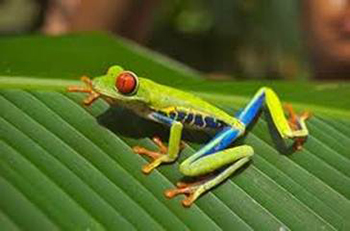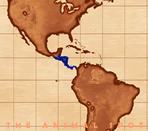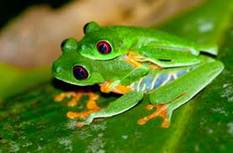The Red-Eyed Tree Frog
Agalychnis calidryas

Taxonomy
Kingdom: Animalia
Phylum: Chordata
Class: Amphibia
Order: Anura
Family: Hylidae
Genus: Agalychnis
Species: calidryas
Description:
The Red-Eyed Tree Frog will grow to be 2 cm in length for males and around 3-4 cm in length for females. It is widely known for its bulging red eyes; blue, yellow, and green mixed body color; and its orange toes. When the Tree Frog sleeps, it hides its distinct colors, but the frog displays its colors if it is being chased to confuse or disinterest the predator. Similar to other Tree Frogs, the Red-Eyed Tree Frog has suction cups for climbing along its toes that allows it to climb trees and leaves. Their long limbs actually suit them to be better climbers than swimmers. Since the frog is in the Hylidae family, it has a third eye lid called a nictitating membrane that protects its sensitive eye from dangers. It gives the eye the red color but does not restrict its vision.
Habitat:
The Red-Eyed Tree Frog is found in lowland rainforests along streams, ponds, and rivers due to the need of water for their offspring will need to mature. They usually live in communities around a water source and are completely arboreal (tree dwelling) as they rarely touch ground.
Location
 The Red-Eyed Tree Frog can be found in locations such as Southern Mexico and parts of Central America including but not specifically Honduras, Costa Rica, Panama, and northern South America.
The Red-Eyed Tree Frog can be found in locations such as Southern Mexico and parts of Central America including but not specifically Honduras, Costa Rica, Panama, and northern South America.
Behavior
They are nocturnal animals so they hunt and wonder at night. If startled during the day as they are sleeping on the underside of leaves, they will quickly pop their bright red eyes open in defense to turn away a predator that possibly sees eyes as big as theirs. Their body colors also aid them if spotted by a predator as they quickly move and these bright colors flash into view throwing off the predator.

Reproduction
In reproduction, the Red-Eyed Tree Frog will lay eggs on the underside of leaves that are above a water source. As the eggs hatch, the fluid that was inside the egg helps to wash the tadpoles into the water. The months of mating are October through March and begin with a male croaking to attract a female. The males will undergo wrestling for the female, the male who is essentially the last one standing on the branch will latch onto the females back as they hang upside down on the bottom of a leaf. The female will lay her eggs one at a time as the male fertilizes it. The female must stay hydrated as the eggs need much fluid to survive. The female often has to move to get water and the male must stay latched on or risk losing his spot to another male. After a few days the eggs hatch and the tadpoles are released into the water where they mature to frogletts then take to land.
Diet
The Red-Eyed Tree Frog will eat mostly insects (moths, crickets, grasshoppers, flies) and also smaller frogs as it is a carnivorous animal.
Economic Importance/ Ecology
The Red-Eyed Tree Frog is a very popular pet for trade due to its beautiful colors. Their ecological importance stems from the fact that they and other amphibians are thought to suffer from environmental effects earlier that alerts humans of the change.
Personal Interest
I am personally interested in the Red-Eyed Tree Frog as it is a known worldwide and It’s beautiful colors make it almost impossible to forget. Also, its bulging red eyes seem to stick with you once noticed. Its defense is really interesting as well as how it is very popular among amphibian lovers as a pet.
References
Please note that the following references may have either been removed or relocated by the webpage owners since the time this student report was created.
- "Red-Eyed Tree Frog." . Rainforest Animals, 2007. Web. 30 May 2012. <http://www.rainforestanimals.net/rainforestanimal/redeyedtreefrog.html>.
- Dorota, . "Red-Eyed Tree Frog." All about frogs. Frogland, 2005. Web. 30 May 2012.< http://allaboutfrogs.org/info/species/redeye.html>.
- "Red-Eyed Tree Frog." . Honolulu Zoo, 2008. Web. 30 May 2012. <http://www.honoluluzoo.org/Red-eyed_Tree_Frog.htm>.
- Col, Jeananda. "Frog, Red-Eyed Tree." enchantedlearning. N.p., 2001. Web. 30 May 2012.< http://www.enchantedlearning.com/subjects/amphibians/redeyedtreefrog.shtml>.
- Boman, B. "Agalychnis callidryas" (On-line), Animal Diversity, 2002. Web. Accessed 30 May 2012 <http://animaldiversity.ummz.umich.edu/site/accounts/information/Agalychnis_callidryas.htm>l